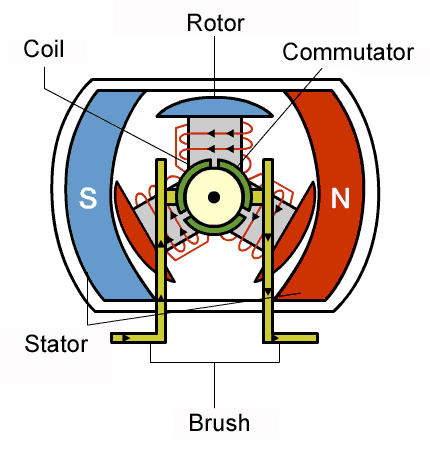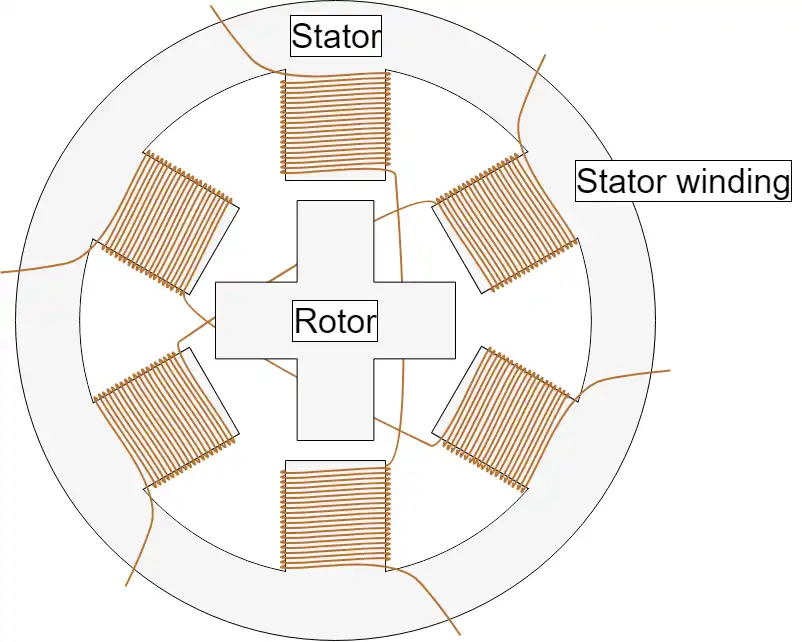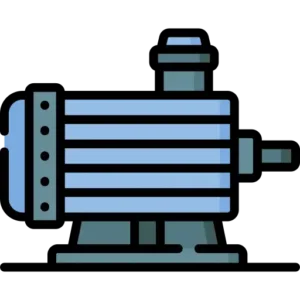Selecting the right electric motor type for your business is important.
Whether you’re a purchase manager or just stepping into this field, facing lots of options makes you confusing.
But how do you determine if it’s the ideal match for your project or industrial application needs? Let’s simplify the process and work together, so you can make a wonderful motor decision following LUPMOTORS.
Type of the Electric Motors

Electric motors are widely used in various fields of our lives and industries. According to different needs and applications, they are mainly divided into the following types:
AC Motors
AC motors are divided into asynchronous motors (induction motors) and synchronous motors.
Asynchronous motors (induction motors)
Asynchronous motors, also known as induction motors, are key devices for converting electrical energy into mechanical energy.
Through the relative movement between the rotating magnetic field generated by the stator and the rotor winding, the rotor winding cuts the magnetic flux lines, thereby generating an induced electromotive force.

This induced electromotive force forms an induced current in the rotor winding.
Subsequently, the induced current interacts with the magnetic field of the stator to generate electromagnetic torque, thereby driving the rotor to rotate and achieve mechanical energy output.
Asynchronous motors are further divided into squirrel cage induction motors and wound rotor motors.
Squirrel Cage Induction Motors
The rotor winding consists of multiple bars inserted into the rotor slots and two annular end rings.
This structure is similar to a squirrel cage, so it is called a cage winding.

Usually, small and medium-sized rotors are made using cast aluminum technology.
This design can effectively improve the durability and performance of the motor while ensuring high strength, and is particularly suitable for heavy machinery applications.
Wound rotor motors
The winding of the wound rotor is similar to the stator winding, usually with a double-layer winding design, and is widely used in medium-sized motors.
Its three-phase winding is usually connected in a star structure, with three end wires connected to three copper (or steel) slip rings mounted on the shaft and connected to the external circuit through brushes.
This design enables the wound rotor to better adjust the starting current and torque, and is particularly suitable for equipment with high starting performance requirements, such as cranes and elevators.
Synchronous motors
Synchronous motors differ from induction motors in that they run at a constant speed that is synchronized with the mains frequency.
Synchronous motors generate torque through the interaction between the excitation magnetic field and the rotating magnetic field of the armature, and rotate at synchronous speed.
Because the rotation speed of its rotor is exactly the same as the speed of the rotating magnetic field generated by the stator winding, it is called a synchronous motor.
Although synchronous motors and asynchronous motors (induction motors) are both common AC motors and their stator winding structures are similar, they have significant differences in operating characteristics.
The speed of an asynchronous motor depends on the torque acting on it, and the speed will change as the load changes; while the synchronous motor has constant speed characteristics, and the speed is always synchronized with the power frequency regardless of how the load changes.
Application of synchronous motors
- power systems
- industrial automation
- transportation
- household appliances
- machine tools
- air conditioners
- elevators
- transportation vehicles
DC Motors
DC motors are well known for their simplicity and ease of control. DC motors can be divided into brushed DC motors and brushless DC motors.

Brushed DC motors
The main components of the motor include a stator made of permanent magnetic material, a rotor (armature) with coil windings, a commutator, and brushes.
When DC current is passed through the A and B ends of the brush, the commutator automatically changes the direction of the rotor magnetic field, thereby driving the rotor of the DC motor to continue to operate.

Types of Brushed DC motors
Brushed DC motors are mainly divided into four types according to their excitation methods:
- separate excitation
- parallel excitation
- series excitation
- compound excitation
Excitation refers to the device that provides power to the stator of a generator or synchronous motor.
During the operation of the DC motor, the excitation adjusts the change of the magnetic field by controlling the voltage of the stator, thereby changing the speed of the motor.
Different excitation methods are suitable for different applications.
1.Shunt motor
The field winding of a shunt motor is connected in parallel with the armature winding.
For a shunt generator, the field winding is powered by the terminal voltage generated by the motor itself; for a shunt motor, the field winding and the armature winding share the same power supply.
In terms of performance, a shunt motor is similar to a separately excited DC motor and has a relatively stable speed characteristic.
2. Series motor
The field winding of a series motor is connected in series with the armature winding and then connected to a DC power supply.
Since the field current is the same as the armature current, this motor can provide high torque at low speeds and is suitable for applications that require strong starting.
3. Compound motor
The compound motor has both shunt and series excitation field windings.
If the magnetomotive force generated by the series winding is in the same direction as the magnetomotive force generated by the shunt winding, this motor is called a product compound motor;
if the two magnetomotive forces are in opposite directions, it is called a differential compound motor.
Compound motors combine the advantages of shunt and series motors and are suitable for complex applications with high requirements for speed and torque.
4. Self-excited motor
There is no direct electrical connection between the excitation winding and the armature winding of the self-excited motor.
Instead, the excitation winding is powered by an external DC power supply.
Permanent magnet motors can also be regarded as self-excited or self-excited motors, but are usually directly called permanent magnet excitation.
This design gives the self-excited motor great flexibility in speed regulation and stability, and is suitable for a variety of precision control applications.
Advantages and Applications
This motor provides high starting torque and is commonly used in small appliances and automotive systems.
Brushless DC motors
The biggest difference between a brushless motor and a brushed motor is that it has no brushes, which not only reduces maintenance needs but also significantly extends the service life of the motor.
Brushless DC motors (BLDC) use electronic commutators instead of traditional mechanical commutators.
Therefore, BLDC motors not only retain the excellent speed regulation performance of DC motors, but also have the simple structure, no commutation sparks, and reliable operation of AC motors.

This design makes brushless motors popular in applications that require high efficiency, low maintenance and long life, especially in industrial and consumer electronics where precision control and reliability are required.
Advantages of brushless motors
- Better speed-torque characteristics
- Fast dynamic response
- Under the same load and speed, the operating efficiency of BLDC motor is significantly higher than that of brushed DC motor
- Lower maintenance requirements
- Long service life
- Noiseless operation
Applications of brushless motors
- electric vehicles
- drones
- electrical appliances
- aerospace
- consumer products
- medical
- industrial automation equipment
Special Electric Motors
Stepper Motor
A stepper motor is a motor that rotates a shaft in steps, i.e., by a fixed angle at a time.
Its internal structure is designed so that the position of the shaft can be accurately determined by simply counting the number of steps without the use of sensors.
This property makes stepper motors very useful in a variety of applications that require precise control of position and speed.

Like other types of motors, stepper motors consist of a fixed part (stator) and a moving part (rotor).
The stator is covered with gear-like protrusions around which coils are wound, while the rotor can be either a permanent magnet or a variable reluctance core.
We will discuss different types of rotor structures in more detail later.
Figure 1 shows a cross-section of a stepper motor with a variable reluctance core as the rotor.

The basic operating principle of a stepper motor is as follows: When one or more stator phases are energized, the current flowing through the coils creates a magnetic field, and the rotor automatically aligns with this magnetic field.
By applying voltage to different phases in sequence, the rotor will rotate by a specific angle until the desired position is reached.
Figure 2 illustrates this operating principle.

First, coil A is energized and generates a magnetic field, and the rotor is aligned with the magnetic field;
when coil B is energized, the rotor rotates 60° clockwise to align with the new magnetic field;
then, coil C is energized, and the rotor will rotate the corresponding angle again to align with the new magnetic field.
The color of the stator teeth in the figure indicates the direction of the magnetic field generated by the stator winding.
Application of Stepper Motor
- robots
- cameras
- engraving machines
- ATMs
- CNC machine tools
- 3D printers
Servo Motor
The “servo” in servo motor actually refers to the control system.
In the field of science and technology, the controlling side is usually called the “master” and the controlled side is called the “slave”.
It is said that both the words “servo” and “slave” come from the Latin “Servus” (meaning slave).
Therefore, the name “servo motor” originally means a motor that “faithfully performs work according to instructions”.
Any motor that can accurately control parameters such as rotational position and speed can be called a “servo motor” regardless of its specific mechanism.
Due to this broad definition, stepper motors and ironless motors are sometimes included in the category of servo motors.
However, here we will focus on those types of servo motors that are equipped with encoders (for detecting rotational position) and use this information to control speed and position (angle) through the driver.
This type of servo motor is widely used in fields that require precise motion control due to its high-precision control capabilities.
Application of Servo Motor
- automation systems
- robotics
- remote-controlled toys
Factors to consider when selecting a motor
Power requirements
It is important to ensure that the power output of the motor accurately matches the needs of the application.
If the power is too large, it may lead to energy waste and low efficiency.
If the power is too small, it may not be able to meet the load requirements or even cause equipment damage.
efficiency
High-efficiency electric motors typically have a higher initial cost, but they can provide significant cost savings over the long term by reducing energy consumption.
Choosing a high-efficiency electric motor can help improve overall system economics.
Cost and Maintenance
When selecting an electric motor, consider not only the initial purchase cost but also evaluate its long-term maintenance needs.
Some electric motors, although less expensive, may require frequent maintenance, increasing the cost of use.
Therefore, the balance between initial investment and long-term maintenance costs is crucial.
Specific application requirements
Choose based on the requirements of your specific application.
For example, is precise speed and position control required?
Does the motor need to operate in special environments, such as high temperature or humid conditions?
These specific needs will directly affect the selection of electric motors.
Conclusion
Overall, choosing the right motor type depends on your specific needs.
Whether you are looking for an AC motor for industrial use or a DC motor for precision control, the key is to have a deep understanding of your options.
During the decision-making process, it is important to consider key factors such as power requirements, efficiency, and cost to ensure that the motor not only meets current performance requirements but also provides the best economic benefits in the long run.









